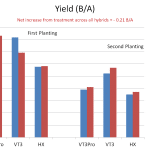We are at the stage of development when questions are coming in about the value of spraying insecticides on field corn at early tassel. This is usually a piggyback application where a pyrethroid insecticide is added to the fungicide. The potential value of this insecticide spray is highly dependent what’s in the field. However, the first thing I should point out is that scheduled sprays are rarely timely and often miss the target (assuming there is one). I’ve demonstrated excellent yield increases from foliar sprays on non-Bt corn in the presence of significant corn borer populations. However, Bt corn provides near perfect control of southwestern and European corn borers. I’ve struggled to show a yield response with foliar insecticide applications on Bt corn. Corn earworms and Japanese beetles are commonly mentioned as targets of these timed sprays. See my previous blog article about silk clipping caused by Japanese beetles in corn. The point of this article is that Japanese beetles can, in rare circumstances, reduce yields by feeding on silks and reducing pollination. However, a suggested threshold of 3 Japanese beetles (on average) per ear appears appropriate.
So can you control corn earworm and reduce kernel damage with a single application of insecticide? The conventional wisdom is no. Spraying before silk emergence misses the target as nearly all corn earworm eggs are laid on silks. Also keep in mind that silks grow rapidly for the first 5-7 days, so fresh and unexposed silks may emerge after treatment. Egg laying can persist for 2-3 weeks. Thus, you are asking a lot if you expect good control from one application. In cases of high and continuing corn earworm pressure, one spray will provide very little or no control. Having said all this, I did show a reduction in kernel damage caused by corn earworm in tests last year when one insecticide application was made (results linked below).
Test 1: Non-Bt corn sprayed 2-3 days after silking began: Kernel reduction ranged from about 18-63% depending upon the treatment, with the insecticide Prevathon tending to provide the best control. Yields were not statistically improved by any treatment, but there was a modest trend of increased yield with most treatments. This might be better explained by the presence of some corn borers at a final infestation level of 13% in untreated plots, and you will notice the best yielding treatment (Intrepid) provided the least amount of kernel protection.
Test 2: Non-Bt corn sprayed about 10-12 days after silking began: A lower, non-significant reduction in kernel damage was observed in this test (almost certainly some larvae were already in the ears at the time of application). There is not any obvious yield trends, with yields of various treatments bouncing all over the place.
Early, in-season counts of damaged kernels are relative high as we are counting all damage in the tip. However, this can be misleading. Damage ratings just prior to harvest are typically much lower because the tip kernels did not develop, damaged or otherwise.
A third test was done with in Jackson with three Bt hybrids including a Herculex, VT3 and VT3Pro. For each hybrid, we had treated and untreated plots. In treated plots, the silks of every ear were hand sprayed with Prevathon 2-3 times per week for several weeks. We had two planting dates. These multiple treatments greatly reduced kernel damage but decreased kernel damage did not correlate with increased yield (see graphs below and click to enlarge). I should point out that there was high and continuous corn earworm pressure in these tests.
Pyrethroid insecticides are the common choice for these piggyback applications because they are relatively inexpensive. There is a push to use Prevathon, which is considerably more expensive insecticide. Prevathon is an excellent product for control of caterpillar pest, providing substantially more residual control than the pyrethroids, but you should not expect any control of non-caterpillar pests such as Japanese beetles and stink bugs
I always encourage growers to experiment and evaluate results on their farms. However, the data I’ve collected for Tennessee would suggest early-tassel insecticide sprays to Bt corn are hard to justify. I’ve not been able to document impacts on yield (admittedly in limited testing). I’ve done more testing in non-Bt corn over the year, with variable results where yield increases correspond best with how many corn borers are present, how well the spray is timed, and how late the corn was planted.



